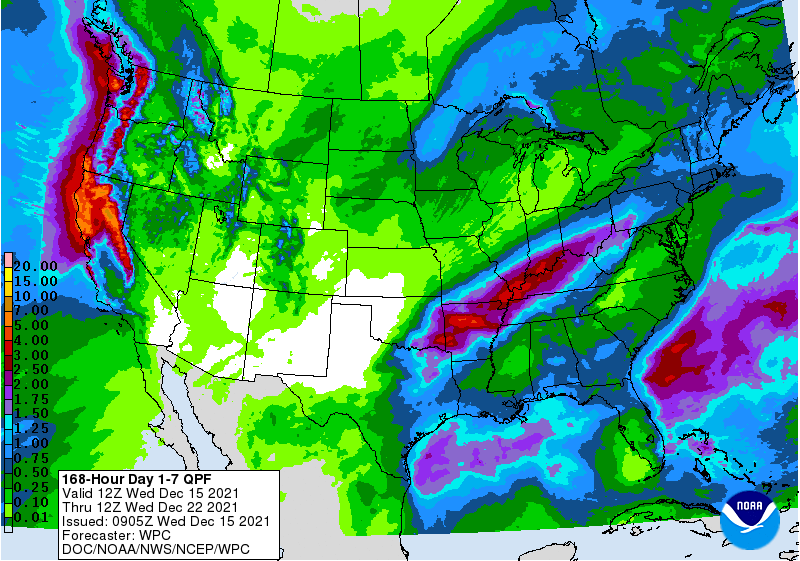PDF Attached
Soybean
meal/oil spreading reversed after NOPA reported less than expected soybean oil stocks and US soybean meal yield rose from the previous month. The US crush came in 2.2 million bushels below trade expectations, but nearby beans settled higher. US wheat sold
off after Algeria bought wheat from mostly the Black Sea region and talk of improving harvesting weather across Australia. Corn traded two-sided. Corn followed meal to the upside earlier but after meal broke and wheat made another leg lower, corn prices
eroded. The weekly EIA ethanol production was about as expected and stocks increased a large amount. US gasoline stocks continue to recover.
WEATHER
EVENTS AND FEATURES TO WATCH
- Typhoon
Rai was still expected to move through the central Philippines Thursday into Friday. - The
storm will produce very heavy rain and flood conditions across the southern Visayan Islands and produce very strong wind speeds - Rainfall
of 5.00 to 15.00 inches will be possible - Wind
speeds will be near 100 mph when the storm begins its trek across the archipelago - Damage
to crops and property will be possible. - At
0900 GMT today, the storm was 613 miles east southeast of Manila, Philippines producing sustained wind speeds to 92 mph and gusts to 115 mph - Movement
was west northwesterly at 12 mph - The
storm will end up over the South China Sea late this week and it may dissipate next week over open water - A
close watch on its movement will be needed since it could pose a threat to Vietnam - Snow
will accumulate throughout the western CIS (Russia, Belarus, The Baltic States and Ukraine) over the next week to ten days while temperatures trend colder - Wheat,
barley, rye and rapeseed will be adequately protected against the cold and winterkill is not expected - Southern
Brazil dryness is expected to expand and deepen over the next ten days - Western
Parana, far southern Mato Grosso do Sul and southeastern Paraguay already have a notable dryness issue with crop stress impacting crops - A
poor rainfall distribution in these areas will continue through the next ten days and perhaps longer - Dryness
is also expected to expand into Rio Grande do Sul and eastern Argentina as time moves along - Northern
Brazil rainfall will remain frequent and abundant with local bouts of flooding possible - No
serious flood event is expected and most crops will continue to develop well from Mato Grosso to Bahia, Minas Gerais and Sao Paulo - Concern
about northern Brazil rainfall and wet biases may rise in early January as soybeans mature and are harvested - Less
rain may be needed to promote the best harvest season - Argentina
soil moisture is still rated quite favorably, despite some restricted rainfall recently - The
heart of summer grain and oilseed production areas from central Buenos Aires to southern Cordoba, southern Santa Fe and northeastern La Pampa have nearly ideal soil moisture for long term crop development - Dryness
is present in parts of the northwest and east-central crop areas, but it has not festered long enough to have a serious impact on production potentials - Argentina
rainfall will be more limited in the coming week to ten days than in the past ten days and temperatures will be quite warm to hot in the central and north late this week through early next week - Accelerated
drying will induce greater crop stress across the northern and east-central parts of the nation and the heart of summer crop country will experience some net drying - Argentina
rainfall Tuesday was mostly concentrated on southern Cordoba and northeastern La Pampa into southern Entre Rios - A
few other showers occurred in northwestern Cordoba and southeastern Buenos Aires - Net
drying occurred elsewhere - Temperatures
were seasonable - Brazil
rainfall Tuesday and early today was greatest from eastern Mato Grosso through western and southern Goias and easternmost Mato Grosso do Sul to southern Minas Gerais and Sao Paulo - The
moisture was great in maintaining a good outlook for summer crop development - Temperatures
were seasonable - U.S.
hard red winter wheat areas will be mostly dry for the next two weeks - Some
of this dry bias will also impact a part of the western U.S. Corn Belt - Very
warm temperatures and a strong, drying, wind is likely today that will induce some blowing dust and property damage - Wind
gusts of 60-80 mph will be possible in a part of the region today - Temperature
extremes will reach above 80 degrees Fahrenheit briefly as they were Tuesday in western Oklahoma and eastern parts of the Texas Panhandle - Very
low humidity is expected over the next couple of days, but especially today resulting in a further loss in soil moisture - Cooling
is expected later this week, but the dry bias will prevail - U.S.
lower Midwest, northern Delta and Tennessee River Basin will be vulnerable to another round of strong to severe thunderstorms Friday into Saturday - Heavy
rainfall is expected and possible local flooding - Rainfall
of 1.00 to 3.00 inches and locally more will be possible from southeastern Missouri to the lower Ohio River Valley and areas south into the northernmost Delta.
- Intense
weather will occur in the upper U.S. Midwest today into Thursday with strong wind speeds, unusually warm temperatures initially and then much colder temperatures, a risk of thunderstorms and then some heave snow and blizzard conditions - These
conditions are most likely in Minnesota, the eastern Dakotas and a few areas in Iowa and northeastern Nebraska - Southern
California received some of its first significant rain of the season Tuesday while drier conditions evolved briefly in northern California and the Sierra Nevada - Another
wave of rain and snow will impact all of California today and Thursday - The
drought is far from being over, but any and all rain and snow is welcome - More
moisture is expected early next week and in the second weekend of the two-week outlook - The
moisture will continue to provide increasing mountain snowpack and a boost in topsoil moisture - U.S.
southeastern states and Delta get a mix of rain and sunshine during the next two weeks maintaining a favorable moisture balance, although parts of the southeastern states will need greater rain prior to spring - Unusual
warmth in the eastern half of the United States over the next few days will minimize heating fuel demand - Bitter
cold air in Canada’s Prairies over the next few days may seep into a part of the northern U.S. Plains, but is not poised to come any farther south for now - West
Texas precipitation will be limited over the next two weeks, but with much of the harvest done there the impact will be low - West
Texas like much of the southwestern Plains needs moisture for soil improvements ahead of planting in the spring - Sunday
will be the earliest that a chance for showers will evolve, but after that dry conditions will prevail - Excessive
wind in the region today may cause some damage and could blow unharvested cotton out of some bolls.
- Australia
winter crop harvest weather has been good recently and will continue more favorably through the next ten days
- No
more crop quality concerns are expected through at least Dec. 26, despite some shower activity infrequently.
- Australia
summer crop conditions are also improving after abundant to excessive rain ended recently - China’s
weather will continue rather tranquil through the next ten days to two weeks with brief periods of precipitation and more sunshine
- Temperatures
will be non-threatening to wheat, rapeseed and livestock - Southern
India weather has been improving recently and this trend will continue for a while - Too
much rain in November hurt the quality of some late season crops and raised the need for replanting of many winter crops - Absolute
dryness is not likely, but rain expected should be brief and light enough to allow some crop development and farming activity to advance relatively well.
- Central
and northern India weather will remain good for winter crop planting and establishment. - Most
winter crops are likely in the ground and are establishing well - Early
planted wheat and other small grains may be in the vegetative to early joint stage of development - Harvest
progress for summer crops has advanced well recently and little change is expected - Precipitation
expected late next week in the far north will be good for some winter crops, although the event is too far out to have high confidence in its occurrence - Morocco
and northwestern Algeria remain too dry and significant rain must fall soon to get crops planted and established properly - Rain
potentials are improving for next week, although no general soaking rain is expected - Soil
moisture and rainfall have been sufficient in northeastern and north-central Algeria and far northern Tunisia, but greater rain is needed in interior crop areas - Europe’s
weather is expected to be tranquil during the next ten days - Romania
and Spain are the two driest countries in the continent today, although some rain fell in parts of Romania recently - Spain
is expected to remain dry biased for an extended period of time - Soil
moisture elsewhere in Europe has been and will continue to be favorable for winter crops which are dormant or semi-dormant in many areas - Very
little rain will fall in western Europe for the next seven days and perhaps longer - Western
parts of Russia, Belarus and central and western Ukraine will get periods of rain and snow through the next ten days maintaining favorable soil moisture for use in the spring - No
crop damaging cold is expected in any winter crop region, although cooling is expected this weekend into next week and that should bring snow to many areas deep into Ukraine and Russia’s Southern Region - Temperatures
may turn cold enough to threaten crops next week, but the snow should provide adequate protection against the cold - South
Africa summer crops will experience a good mix of rain and sunshine over the next ten days supporting additional planting and establishment - Production
potentials are good this year especially with La Nina prevailing - West-central
Africa rainfall is expected to be confined to coastal areas only - Favorable
crop maturation and harvest conditions will prevail in most coffee, cocoa, sugarcane, rice and cotton production areas - Ethiopia
rainfall will be minimal over the next seven days resulting in net drying conditions which are not unusual at this time of year - Showers
and thunderstorms will occur routinely in coffee, cocoa, rice and sugarcane areas from Tanzania into Uganda and Kenya through December 17 - Indonesia,
Malaysia and Philippines rainfall will be widespread over the next two weeks, but its intensity should be lighter than usual
- The
only exception will be in the central and southern Philippines where a tropical cyclone is expected to pass later this week - Mainland
areas of Southeast Asia will see seasonable drying over the next ten days, although coastal areas of Vietnam will receive frequent rain later this week and into the weekend - North-central
and northeastern Mexico will get some precipitation Saturday into the Monday
- Another
round of rain may impact northwestern Mexico Wednesday into Thursday of next week with a little more rain in the following weekend
- The
moisture will be beneficial for winter crops, although more will be needed - Showers
elsewhere will be erratic and mostly light over the next ten days - Central
America precipitation will be greatest along the Caribbean Coast , but including a fair amount of Panama and Costa Rica - Middle
East weather is a little dry from Syria, Iraq, Israel and Jordan to Iran while portions of Turkey have favorable soil moisture.
- Not
much change is expected through mid-week this week - Rain
late this week and into the following weekend may impact a few northern Iraq and western Iran locations while other areas from Syria to Jordan and Israel will remainder biased through most of next week - Colombia
and Venezuela precipitation is expected to occur periodically in coffee, corn, rice and sugarcane production areas during the next ten days, but no excessive rain is expected - Tuesday’s
Southern Oscillational Index was +11.77 and it was expected to move erratically over the coming week - New
Zealand rainfall has been heavy recently, but drier biased weather is now expected for a little while except along the lower west coast of South Island where some rain will fall - Temperatures
will be seasonable
Wednesday,
Dec. 15:
- EIA
weekly U.S. ethanol inventories, production - U.S.
Green Coffee Association releases monthly inventory data, 3pm - Brazil’s
Unica publishes cane crush, sugar output data (tentative) - Malaysia’s
Dec. 1-15 palm oil exports
Thursday,
Dec. 16:
- USDA
weekly net-export sales for corn, soybeans, wheat, cotton, pork, and beef, 8:30am - Port
of Rouen data on French grain exports - HOLIDAY:
Bangladesh
Friday,
Dec. 17:
- ICE
Futures Europe weekly commitments of traders report (6:30pm London) - CFTC
commitments of traders weekly report on positions for various U.S. futures and options, 3:30pm - USDA
FAS issues world coffee report, with supply-demand data
Saturday,
Dec. 18:
- China’s
2nd batch of Nov. trade data, including imports of cotton, corn, wheat, and sugar
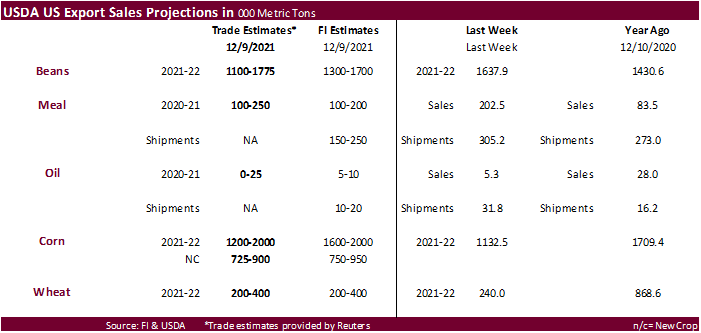
Macros
FOMC
Benchmark Interest Rate Unchanged; Target Range Stands At 0.00% – 0.25%
–
Interest Rate On Excess Reserves Unchanged At 0.15%
FOMC
Doubles Pace Of Bond Taper To $30Bln From $15Bln
Fed
Median Forecast Shows Three Hikes In 2022, Three In 2023
US
Empire Manufacturing Dec 31.9 (est 25.0; prev 30.9)
US
Retail Sales (M/M) Nov 0.3% (est 0.8%; prev 1.7%; prevR 1.8%)
–
US Retail Sales Ex. Auto (M/M) Nov 0.3% (est 0.9%; prev 1.7%; prevR 1.8%)
–
US Retail Sales Ex. Auto & Gas (M/M) Nov 0.2% (est 0.8%; prev 1.4%; preR 1.6%)
–
US Retail Sales Control Group (M/M) Nov -0.1% (est 0.7%; prev 1.6%)
US
Import Price Index (M/M) Nov 0.7% (est 0.6%; prev 1.2%; prevR 1.5%)
–
US Import Price Index Ex. Petroleum (M/M) Nov 0.7% (est 0.4%; prev 0.5%; prevR 0.6%)
–
US Import Price Index (Y/Y) Nov 11.7% (est 11.4%; prev 10.7%; prevR 11.0%)
–
US Export Price Index (M/M) Nov 1.0% (est 0.5%; prev 1.5%; prevR 1.6%)
–
US Export Price Index (Y/Y) Nov 18.2% (prev 18.0%)
Canadian
CPI (M/M) Nov 0.2% (est 0.2%; prev 0.7%)
–
Canadian CPI (Y/Y) Nov 4.7% (est 4.7%; prev 4.7%)
Canadian
Housing Starts Nov 301.3K (est 235.0K; prev 236.6K; prevR 238.4K)
US
NAHB Housing Market Index Dec: 84 (est 84; prev 83)
US
Business Inventories Oct: 1.2% (est 1.1%; prev 0.7%; prevR 0.8%)
US
DoE Crude Oil Inventories (W/W) 10-Dec: -4584K (est -1700K; prev -241K)
–
Distillate: -2852K (est 1000K; prev 2733K)
–
Cushing: +1294K (prev 2373K)
–
Gasoline: -719K (est 2050K; prev 3882K)
–
Refinery Utilization: 0.00% (est 0.50%; prev 1.0%)
UK
reports 78,610 new coronavirus cases, by far the biggest one-day increase on record
·
Corn traded two-sided, ending lower. December 2022 corn futures gained on March 2021. Many traders are looking for high input costs (fertilizers) to trim 2022 US corn acres. Today corn futures followed meal to the upside earlier
but after meal broke and wheat made another leg lower, corn prices eroded. Lack of US corn export developments and lack of news weighed on prices. Over the short term, a break in soybean meal may keep corn futures in a two-sided range if wheat futures prices
stabilize over the next two weeks
·
USD was 22 points higher and WTI crude about $0.23 higher by the time corn settled.
·
South America will see favorable precipitation this week.
·
China will revert back to a 12 percent pork import tariff in 2022 after they dropped it to 8% in 2020 after African swine fever decimated hog supplies.
·
Weekly US ethanol production was off 3,000 barrels to 1.087 million, near expectations, and stocks increased for the 4th consecutive session by 419,000 barrels to 20.883 million (trade was looking for a 115,000-barrel
increase). September to date ethanol production is running 1.4% above the comparable period
two years ago. Gasoline stocks increased 509,000 barrels (most for any week since July 2) to 9.472 million barrels, largest since late October.

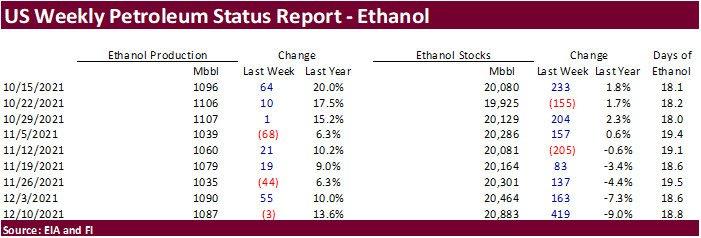
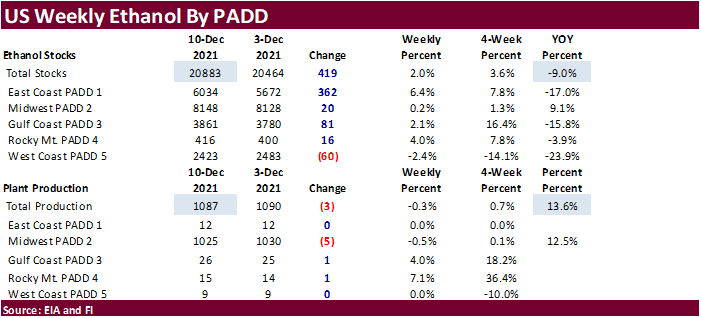
USDA
Broiler Report
showed eggs set in the US up 4 percent from year ago and chicks placed up slightly. Cumulative placements from the week ending January 9, 2021 through December 11, 2021 for the United States were 9.08 billion. Cumulative placements were up slightly from
the same period a year earlier.
USDA
Turkey Hatchery
-
Eggs
in Incubators on December 1 Down 4 Percent from Last Year -
Poults
Hatched During November Up 1 Percent from Last Year -
Net
Poults Placed During November Up 2 Percent from Last Year
Export
developments.
·
None reported
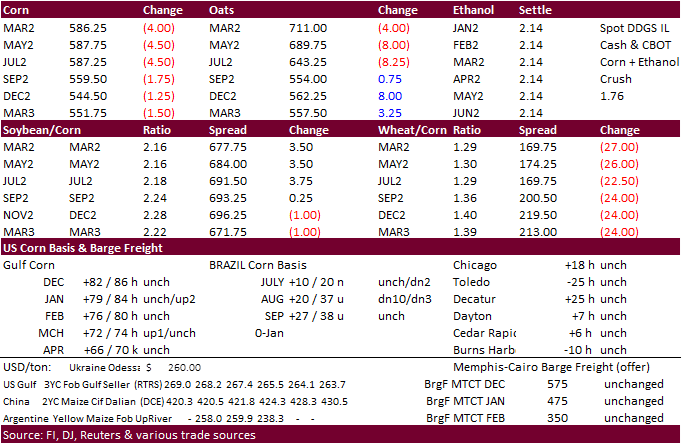
Updated
12/9/21
March
corn is seen in a $5.50 to $6.20 range
·
Soybeans ended higher in the nearby and lower in the far back months on lack of direction. Traders focused on product spreading. SBO started lower following a steep drop in Malaysian palm futures.
·
Soybean meal/oil spreading reversed after NOPA reported less than expected soybean oil stocks and US soybean meal yield rose from the previous month. The NOPA US crush came in 2.2 million bushels below trade expectations, but
nearby beans settled higher.
·
Brazil soybean production was expected to end up near 144.1 million tons, according to a Reuters poll, 5% more than in the previous season. USDA is at 144 million tons.
·
Argentina soybean meal offers appear to be drying up.
·
Argentina Agriculture Ministry: 35.7 MMT of 2020-21 soybeans have been sold, +327,800 tons for week ending Dec 8. This is out of 43.1MMT tons produced in 2020-21.
·
There are some discrepancies in Malaysian palm oil shipment data for FH December, but compared to other years, palm oil shipments were very good (see chart after the text). Cargo surveyor SGS reported month to date December 15
Malaysian palm exports at 896,849 tons, 15,026 tons below the same period a month ago or
down 1.6%, and 171,469 tons above the same period a year ago or up 23.6%. AmSpec reported Malaysian December 1-15 palm oil exports
down 9.1% to 725,600 tons from 798,399 tons same period month ago. ITS reported a
12.5% decline to 772,137 tons.
NOPA’s
November crush of 179.5 million bushels came in below expectations and on a daily rate averaged 5.98 million bushes/day, second largest daily rate in recorded history for any month (behind November 2020 of 6.03 mil bu/day and a hair above October 2020). At
179.5 million bushels for the month, it was the seventh largest crush in our working history and 2.2 million below trade expectations. NOPA reported a much lower than expected US soybean oil yield of 11.76 pounds per bushel, below 11.89 pounds during October,
and that resulted in US soybean oil stocks falling below trade expectations to 1.832 billion pounds, 71 million below trade expectations. Soybean oil stocks increased across the Midwest and northwestern Corn Belt and decreased in all other regions. Soybean
oil production was still a large 2.110 billion pounds, below the record 2.187 billion posted last month. The meal yield came in at 46.83, above 46.62 month earlier and above 47.31 for November 2020. Despite the increase in the soybean meal yield from the
previous month, soybean meal production fell slightly from October to 4.202 million short tons and compares to 4.262 million produced during November 2020.
We
are using 11.72 pounds per bushels for the US soybean oil yield for the crop year, below USDA’s 11.75 and compares to 11.73 during 2020-21.

Export
Developments
·
None reported
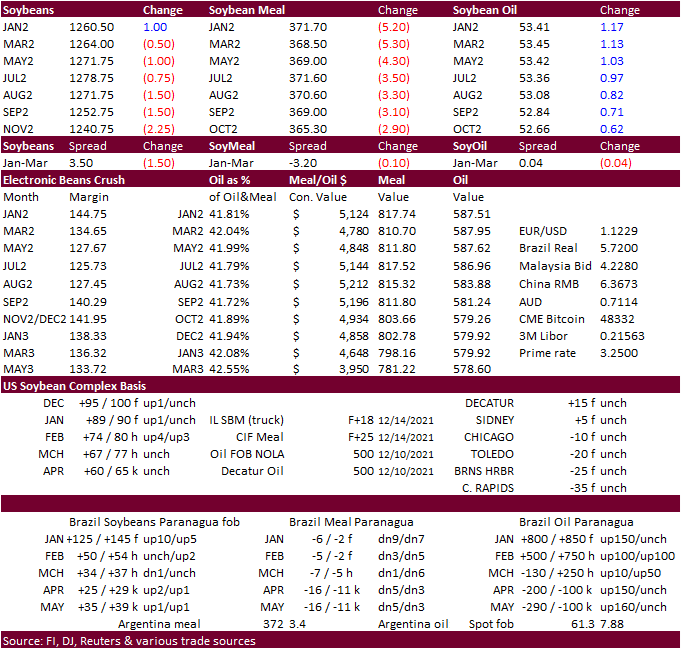
Updated
12/14/21
Soybeans
– January $12.35 to $13.05 range, March $11.75-$13.50
Soybean
meal – January $350 to $400, March $330-$415
Soybean
oil – January 49.50 to 57.00, March 50.00-59.00
·
US wheat traded lower on favorable Australian crop weather facilitating harvest progress and Algeria snapping up mostly Black Sea origin wheat. We are also hearing the quality of the Australian wheat is not as bad as expected.
·
Paris March wheat futures settled 8.50 euros lower at 275.75/ton, lowest level since October 26.
·
(Reuters) – Weekly figures on European Union exports and imports of cereal and oilseed products should be complete from the start of January after a technical problem led to partial data for France in recent months, an EU official
said.
·
South Africa’s Crop Estimates Committee (CEC) estimated the 2021 wheat crop at 2.153 million tons, up from 2.120 million in 2020.
Export
Developments.
·
Japan in a SBS import tender saw no offers for 80,000 tons of feed wheat and 100,000 tons of barley for arrival by March 10.
·
Jordan passed on 120,000 tons of feed barley.
·
Results awaited: Iran’s GTC seeks 180,000 tons of milling wheat on Dec. 15 for shipment in January and February 2022.
·
The Philippines seek 120,000 tons of animal feed wheat on for shipment in 2022 between March and May. The wheat can be sourced optionally from Australia, the United States, Canada, European Union and Black Sea region.
·
Another group from the Philippines seeks up to 220,000 tons of animal feed wheat on Dec. 16 for March 15 to May 31, 2022, shipment. Origins include Australia, Europe or the Black Sea region.
·
Japan’s Ministry of Agriculture, Forestry and Fisheries (MAFF) is seeking to buy a total of 228,783 tons of food-quality wheat from the United States and Canada in regular tenders that will close on Thursday.
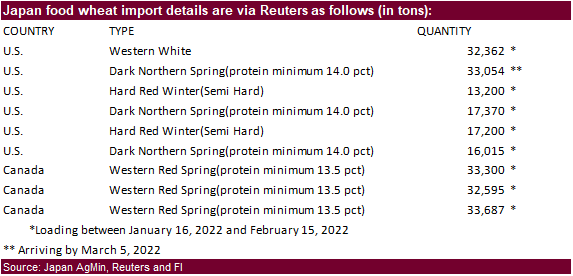
·
Jordan seeks 120,000 tons of wheat on December 16.
·
Turkey seeks about 320,000 tons of 12.5% and 13.5% protein content milling wheat on December 21 for shipment between February 1 and February 28.
Rice/Other
·
South Korean Agro-Fisheries & Food Trade Corp. seeks 22,000 tons of rice from the US, set to close Dec 16.
·
(Reuters) – Vietnam’s coffee exports in November were up 8.3% from October at 107,473 tons, while rice exports for the same period fell 8.4% against the preceding month, government customs data released on Tuesday showed. For
the first 11 months of 2021, Vietnam exported 1.4 million tons of coffee, down 2.3% from a year earlier, Vietnam Customs said in a statement.
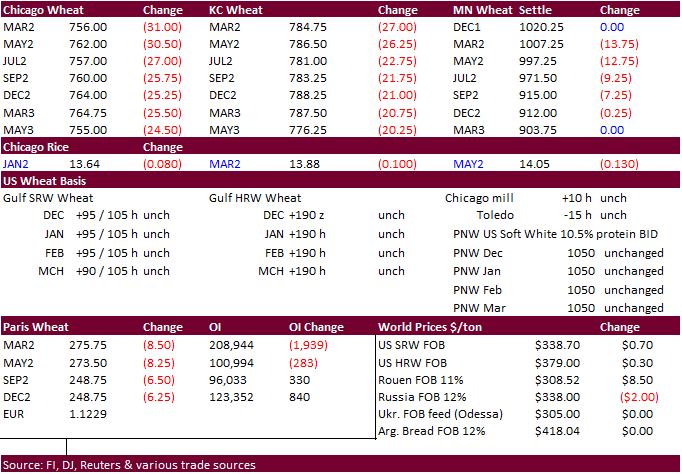
Updated
12/9/21
Chicago
March $7.40 to $8.60 range
KC
March $7.55 to $9.00 range
MN
March $9.50‐$11.00
Terry Reilly
Senior Commodity Analyst – Grain and Oilseeds
Futures International
One Lincoln Center
18 W 140 Butterfield Rd.
Oakbrook Terrace, Il. 60181
W: 312.604.1366
ICE IM:
treilly1
Skype: fi.treilly

Trading of futures, options, swaps and other derivatives is risky and is not suitable for all persons. All of these investment products are leveraged, and you can lose more than your initial deposit. Each investment product is offered
only to and from jurisdictions where solicitation and sale are lawful, and in accordance with applicable laws and regulations in such jurisdiction. The information provided here should not be relied upon as a substitute for independent research before making
your investment decisions. Futures International, LLC is merely providing this information for your general information and the information does not take into account any particular individual’s investment objectives, financial situation, or needs. All investors
should obtain advice based on their unique situation before making any investment decision. The contents of this communication and any attachments are for informational purposes only and under no circumstances should they be construed as an offer to buy or
sell, or a solicitation to buy or sell any future, option, swap or other derivative. The sources for the information and any opinions in this communication are believed to be reliable, but Futures International, LLC does not warrant or guarantee the accuracy
of such information or opinions. Futures International, LLC and its principals and employees may take positions different from any positions described in this communication. Past results are not necessarily indicative of future results.

